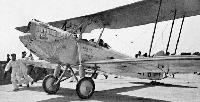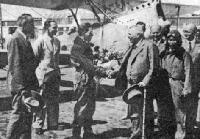Фотографии
-
Described by the international press as “The Lindbergh of Japan”, Seiji Yoshihara stands beside his Armstrong-Siddeley Genet-engined Junkers Junior in which he flew within a week from Berlin to Tokyo via Koenigsberg, Smolensk, Sverdlovsk, Omsk, Krasnoyarsk, Chita, Harbin and Osaka in 1930. He made a failed attempt at a transpacific flight in 1931.
Самолёты на фотографии: Junkers A 50 Junior - Германия - 1929
-
Регистрационный номер: J-BEPB [11] The fuselage of the R-3 was doped silver fabric, overlaid with grey-blue decking from aft of the engine to the tail. Japan’s national hinomaru (‘‘circle of the sun”) with two grey-blue bars was applied to the fuselage and under the wings. The kanji symbols beneath the cockpit read Seinen Nippon, and the characters on the fin read Giyu (“loyalty and courage”) No 10.
Самолёты на фотографии: Ishikawajima R-3 - Япония - 1930
-
Регистрационный номер: J-BEPB [11] One of the six R-3s built, J-BEPB was delivered to Hosei University in March 1931. Stressed for aerobatics, the R-3 was very much the Japanese equivalent of the British D.H.60 Moth, although the military rejected the type as a primary trainer, mainly owing to its troublesome licence-built Cirrus engine.
Самолёты на фотографии: Ishikawajima R-3 - Япония - 1930
-
Регистрационный номер: J-BEPB [11] The pair arrive at a destination on the Korean or Chinese part of their epic journey. The R-3’s Cirrus engine mounting was attached to the fuselage by only four bolts and was built up from Duralumin channels reinforced by a curved Duralumin plate beneath the engine, this plate also serving as the bottom half of the engine cowling.
Самолёты на фотографии: Ishikawajima R-3 - Япония - 1930
-
Регистрационный номер: J-BEPB [11] Ryotaro Kumakawa (left) and Moritaka Kurimura stand beside Ishikawajima R-3 J-BEPB, named Seinen Nippon (Young Japan) at the aircraft manufacturer’s factory at Tachikawa airfield in Tokyo in April 1931, shortly before undertaking their epic 92-day flight to Rome
Самолёты на фотографии: Ishikawajima R-3 - Япония - 1930
-
Регистрационный номер: J-BEPB [11] Japanese Ambassador to Rome Shigeru Yoshida (third from left) greets Kurimura and Kumakawa at Rome-Littorio airfield on the conclusion of the pair’s remarkable flight on August 31, 1931. Third from right is Chan Shiniru, deputy head of Hosei University’s Aviation Research Group.
Самолёты на фотографии: Ishikawajima R-3 - Япония - 1930
-
Регистрационный номер: J-BEPB [11] After its return to Tokyo from Europe by ship in October 1931, Seinen Nippon was immediately reassembled and placed on display in a newly-opened hall at the Tokyo Science Museum, where the Emperor and Empress of Japan inspected the aircraft.
Самолёты на фотографии: Ishikawajima R-3 - Япония - 1930
-
Регистрационный номер: J-BEPB [11] Kurimura (left), who had only just gained his full flying licence, and Kumakawa are presented with bouquets of flowers just before the intrepid pair’s departure from Haneda airfield in Tokyo on the morning of May 29, 1931. Ahead of them lay a journey of almost 8,500 miles (13,700km) over some of the most remote and inhospitable areas on the planet.
Самолёты на фотографии: Ishikawajima R-3 - Япония - 1930
-
Регистрационный номер: J-BEPB [11] Kurimura (left) and Kumakawa pose for a publicity photograph after the delivery of the R-3 to Hosei University. The aircraft was one of 11 of various types, all bearing the symbols for Giyu and a number, donated for good causes by the Maritime Defence Association.
Самолёты на фотографии: Ishikawajima R-3 - Япония - 1930
-
Регистрационный номер: J-BEPB [11] A rare air-to-air photograph of Seinen Nippon in flight. The R-3’s wings - with spars of boxed spruce and three-ply - were of all-wood construction with a three-ply leading edge and were fabric-covered. The aileron hinge points were fitted, so Ishikawajima claimed, to compensate for yaw, thus reducing rudder work for the pilot.
Самолёты на фотографии: Ishikawajima R-3 - Япония - 1930
-
Регистрационный номер: J-BEPB [11] With the first leg from Tokyo completed in exactly four hours, a gleaming Seinen Nippon arrives at Osaka-Tatetsu airfield on May 29, 1931. The following day the pair were to fly over the Sea of Japan, considered a brave undertaking in a light aircraft at the time.
Самолёты на фотографии: Ishikawajima R-3 - Япония - 1930
-
Регистрационный номер: J-BEPB [11] Kurimura (third from left) and Kumakawa (second from right) are greeted by a small welcoming party at Tempelhof airfield in Berlin on July 25, 1931. Berlin had initially been selected as the destination for the flight to Europe, but in the event it was decided to make Rome the final objective.
Самолёты на фотографии: Ishikawajima R-3 - Япония - 1930
Статьи
- -
- A.Metzmacher - Local Hero
- D.Powers - Bunny Power!
- J.Franzi - A Proper Firebomber /An eye for detail/
- J.Knightly - The Last Seagull
- J.Pote - New Year on Skyline Ridge
- J.Stroud - Beirut: Lebanon's Propliner Paradise /The John Stroud Archive/
- K.Hayward - The Blame Game
- M.O'Leary - Magical Mystery Tourer
- N.Braas - Machtrainer
- N.Stroud - The Hot Seat
- P.Davidson - Off the Beaten Track...
- P.Jarrett - Lost & Found
- P.Jarrett - Mr. Cody & Mr. Roe (1)
- P.Thompson - Young Japan
- R.Flude - The Molotov Express











